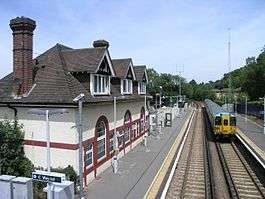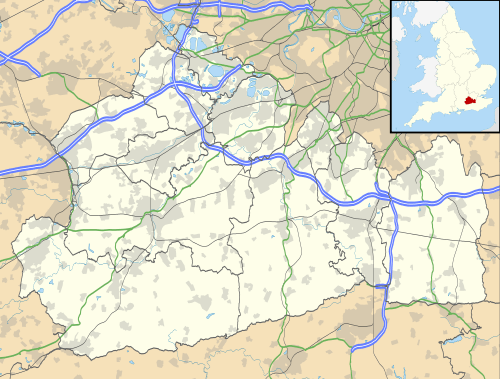Chipstead railway station
Chipstead railway station serves the village of Chipstead in Surrey. It is a late-Victorian station on the Tattenham Corner Line and was opened in 1897. The station and all trains serving it are operated by Southern. It is in Travelcard Zone 6, 18 miles 41 chains (29.8 km) from Charing Cross.
| Chipstead | |
|---|---|
 | |
 Chipstead Location of Chipstead in Surrey | |
| Location | Chipstead |
| Local authority | Borough of Reigate and Banstead |
| Managed by | Southern |
| Station code | CHP |
| DfT category | E |
| Number of platforms | 2 |
| Fare zone | 6 |
| National Rail annual entry and exit | |
| 2014–15 | |
| 2015–16 | |
| 2016–17 | |
| 2017–18 | |
| 2018–19 | |
| Railway companies | |
| Original company | Chipstead Valley Railway |
| Pre-grouping | South Eastern and Chatham Railway |
| Post-grouping | Southern Railway |
| Key dates | |
| 2 November 1897 [2][3] | Opened |
| Other information | |
| External links | |
| WGS84 | 51.309°N 0.169°W |
The station buildings are no longer used by Southern, having been sold off and converted for private use in the mid-late 1990s, and a small ticket office is in a pre-fabricated building on the Up platform.
Services
The typical off-peak service in trains per hour is:[4]
- 2 tph to London Bridge (fast from East Croydon)
- 2 tph to Tattenham Corner
During the peak hours, there are also services to London Victoria.
On Sundays, the service to London Bridge calls at all stations via Forest Hill.
| Preceding station | Following station | |||
|---|---|---|---|---|
| Southern | ||||
gollark: OH BEE OH NO
gollark: Oh, NOW it works.
gollark: <@160279332454006795> I see it insulted me apioformatically. How does that work?
gollark: +>eval_silent for(i=0;i<10;i++)insult(["AI", "dungeon", "bot"]).then(x=>m.channel.send(x))
gollark: +>eval_silent for(i=0;i<10;i++)insult(["crab"]).then(x=>m.channel.send(x))
References
- "Station usage estimates". Rail statistics. Office of Rail Regulation. Please note: Some methodology may vary year on year.
- Chronology of London Railways by H.V.Borley page 50
- Southern Region Record by R.H.Clark page 69
- "Timetable 31 - London to Coulsdon and Tattenham Corner" (PDF). Southern, December 2019.
External links
| Wikimedia Commons has media related to Chipstead railway station. |
- Train times and station information for Chipstead railway station from National Rail
This article is issued from Wikipedia. The text is licensed under Creative Commons - Attribution - Sharealike. Additional terms may apply for the media files.
